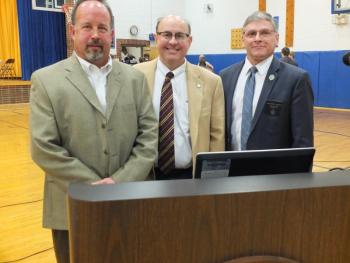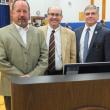Students warned about distracted driving
 AT&T Regional Vice President Owen Smith, Maine Secretary of State Matt Dunlap, and State Senator Chris Johnson (D-Somerville) led a presentation about distracted driving at Boothbay Region High School Jan. 29. BILL PEARSON/Boothbay Register
AT&T Regional Vice President Owen Smith, Maine Secretary of State Matt Dunlap, and State Senator Chris Johnson (D-Somerville) led a presentation about distracted driving at Boothbay Region High School Jan. 29. BILL PEARSON/Boothbay Register
 AT&T Regional Vice President Owen Smith, Maine Secretary of State Matt Dunlap, and State Senator Chris Johnson (D-Somerville) led a presentation about distracted driving at Boothbay Region High School Jan. 29. BILL PEARSON/Boothbay Register
AT&T Regional Vice President Owen Smith, Maine Secretary of State Matt Dunlap, and State Senator Chris Johnson (D-Somerville) led a presentation about distracted driving at Boothbay Region High School Jan. 29. BILL PEARSON/Boothbay Register
Maine Secretary of State Matt Dunlap has a simple message for teen drivers: Keep an eye on the road, not on your phone. Dunlap brought that message to Boothbay Region High School on Jan. 29 as part of a nationwide outreach effort warning teen drivers about the dangers of distracted driving.
An anti-texting and driving program was created by AT&T Wireless Communications seven years ago. Dunlap along with AT&T Regional Vice President Owen Smith of Gorham and State Sen. Christopher Johnson conducted the hour-long presentation in the high school gymnasium.
The presentation shows how cell phones are a major distraction for drivers and distracted driving has become the number one killer of teens nationwide.
Dunlap told the students when he became a licensed driver at age 17 on Mount Desert Island in the 1980s, teen drunk driving was the major concern. But now, three decades later, distracted driving tops the list.
The change is attributed to the proliferation of smart phones. Smith said the majority of AT&T’s customers, whether teen or adult, use smart phones. He estimated smart phones comprised 80 percent of the cell phone market. He shared statistics to reinforce how much cell phones are a part of daily life. In 2013, AT&T customers texted 850 billion times, according to Smith. In 2015, he believed texts would total over a trillion.
The cell phone industry is trying to reverse the trend of teen texting and driving, according to Smith. AT&T has developed a program designed to warn teens about the dangers of distracted driving. Smith presented AT&T’s version, called “It Can Wait.”
Dunlap implores all drivers — young and old — to adhere to the program’s message: Don’t drive distracted.
“If you think it might be that important to respond right away then pull over. It can wait. It’s not worth the risk to drive distracted,” he said.
For those students not persuaded by Dunlap’s plea, the presentation included statistics showing the dangers of distracted driving, especially incidents involving cell phone use. In 2013, distracted driving resulted in 13 percent of road fatalities, and over 422,000 injuries. Nationwide, teen drivers are four times more likely to be involved in distracted driving crashes, according to Smith.
The presentation also included stories from teens whose lives had been permanently affected by distracted driving. “It Can Wait” includes a 10-minute video about the last texts sent by teen drivers.
One took his eyes off the road for a few seconds and ended up killing a bicyclist. His final text was “Where U AT.”
“It Can Wait” hopes its message is clear and wants students nationwide to take the “Not Text and Drive” Pledge.
Boothbay Region junior Chelsie Graves is one of 14 students who signed the pledge by Feb. 1. Graves was motivated by the video’s graphic message of the consequences from distracted driving.
“It’s just not a good thing to do,” Graves said. “The trooper who told about the girl’s last text was really sad. You could see how much the whole thing affected him even though it happened years ago.”
In the past five years, over 7,330,837 teens nationwide have signed the pledge, according to Smith.
Dunlap also reminded students that it was a near certainty that they would be involved in at least one distracted driving incident in their lives. He recounted his experience with a distracted teen driver in Old Town. He was rear-ended by a teen texting while his vehicle was stopped.
“The driver was pretty surprised to find out she hit the car of the Secretary of State,” Dunlap said. “It is a mathematical probability that all of us, one time, will be involved in a crash with a distracted driver at least once.”
Dunlap ended the presentation by saying when he met a BRHS student on the road, he hoped it would be “eye to eye.”
Event Date
Address
United States






















